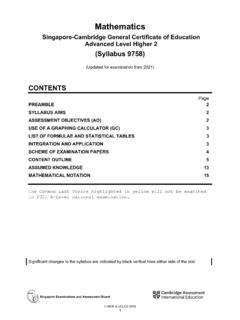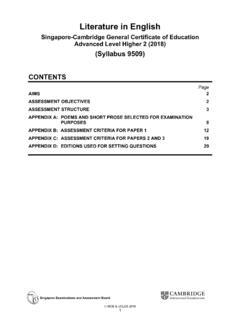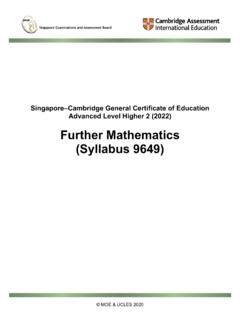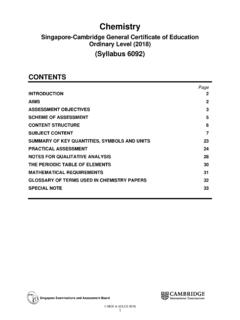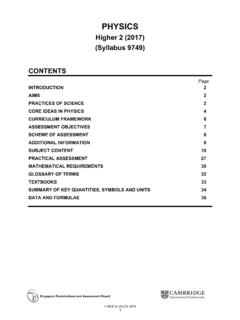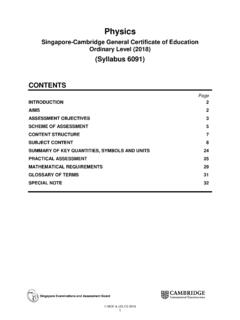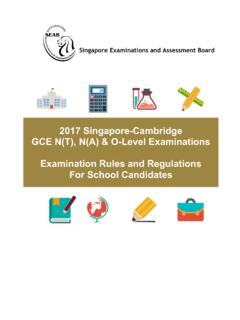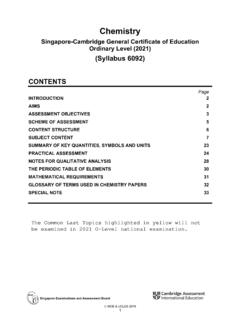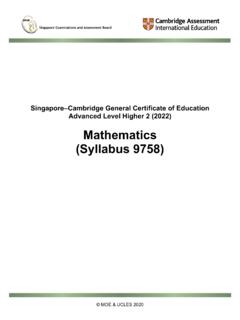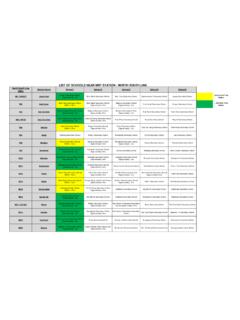Transcription of 4048 y20 sy Mathematics O-Level for 2020 - SEAB
1 MOE & UCLES 20191 Singapore Examinations and Assessment Board Mathematics Singapore-Cambridge General Certificate of Education Ordinary Level (2021) (Syllabus 4048) CONTENTS Page INTRODUCTION2 AIMS 2 ASSESSMENT OBJECTIVES 2 SCHEME OF ASSESSMENT 3 USE OF CALCULATORS 3 SUBJECT CONTENT 4 MATHEMATICAL FORMULAE 11 MATHEMATICAL NOTATION 12 4048 Mathematics GCE ORDINARY LEVEL SYLLABUS (2021) 2 INTRODUCTION The syllabus is intended to provide students with the fundamental mathematical knowledge and skills. The content is organised into three strands namely, Number and Algebra, Geometry and Measurement, and Statistics and Probability. Besides conceptual understanding and skills proficiency explicated in the content strands, development of process skills that are involved in the process of acquiring and applying mathematical knowledge is also emphasised.
2 These include reasoning, communication and connections, thinking skills and heuristics, and application and modelling; and are developed based on the three content strands. AIMS The O-Level Mathematics syllabus aims to enable all students to: acquire mathematical concepts and skills for continuous learning in Mathematics and to supportlearning in other subjects develop thinking, reasoning, communication, application and metacognitive skills through amathematical approach to problem-solving connect ideas within Mathematics and between Mathematics and other subjects through applications ofmathematics build confidence and foster interest in OBJECTIVES The assessment will test candidates abilities to: AO1 understand and apply mathematical concepts and skills in a variety of contexts AO2 organise and analyse data and information; formulate and solve problems, including those in real-world contexts, by selecting and applying appropriate techniques of solution.
3 Interpret mathematical results AO3 solve higher order thinking problems; make inferences; write mathematical explanation and arguments. 4048 Mathematics GCE ORDINARY LEVEL SYLLABUS (2021) 3 SCHEME OF ASSESSMENT paper Duration Description Marks Weighting paper 1 2 hours There will be about 25 short answer questions. Candidates are required to answer all questions. 8050% paper 2 2 hours 30 minutes There will be 10 to 11 questions of varying marks and lengths. The last question in this paper will focus specifically on applying Mathematics to a real-world scenario. Candidates are required to answer all questions. 10050%NOTES of essential working will result in loss of questions may integrate ideas from more than one topic of the syllabus where mathematical formulae will be provided for should have geometrical instruments with them for paper 1 and paper stated otherwise within a question, three-figure accuracy will be required for answers.
4 Thismeans that four-figure accuracy should be shown throughout the working, including cases whereanswers are used in subsequent parts of the question. Premature approximation will be penalised,where appropriate. Angles in degrees should be given to one decimal units will be used in questions involving mass and the 12-hour and 24-hour clock may be used for quoting times of the day. In the 24-hour clock, forexample, will be denoted by 03 15; by 15 are expected to be familiar with the solidus notation for the expression of compound units, 5 cm/s for 5 centimetres per second, g/cm3 for grams per cubic the question requires the answer in terms of , the calculator value for or = should will be provided in each question paper for working and OF CALCULATORS An approved calculator may be used in both paper 1 and paper 2.
5 4048 Mathematics GCE ORDINARY LEVEL SYLLABUS (2021) 4 SUBJECT CONTENT Topic/Sub-topics Content NUMBER AND ALGEBRAN1 Numbers and their operations primes and prime factorisation finding highest common factor (HCF) and lowest common multiple (LCM),squares, cubes, square roots and cube roots by prime factorisation negative numbers, integers, rational numbers, real numbers, and their fouroperations calculations with calculator representation and ordering of numbers on the number line use of the symbols <, >, , approximation and estimation (including rounding off numbers to a requirednumber of decimal places or significant figures and estimating the results ofcomputation) use of standard form A 10n, where n is an integer, and 1 A < 10 positive, negative, zero and fractional indices laws of indicesN2 Ratio and proportion ratios involving rational numbers writing a ratio in its simplest form map scales (distance and area) direct and inverse proportionN3 Percentage expressing one quantity as a percentage of another comparing two quantities by percentage percentages greater than 100% increasing/decreasing a quantity by a given percentage reverse percentagesN4 Rate and speed average rate and average speed conversion of units ( km/h to m/s)4048 Mathematics GCE ORDINARY LEVEL SYLLABUS (2021) 5 Topic/Sub-topics Content N5 Algebraic expressions and formulae using letters to represent numbers interpreting notations.
6 Ab as a b baas a b or a b1 a2 as a a, a3 as a a a, a2b as a a b, 3y as y + y + y or 3 y 3(x + y) as 3 (x + y) 53y+ as (3 + y) 5 or51 (3 + y) evaluation of algebraic expressions and formulae translation of simple real-world situations into algebraic expressions recognising and representing patterns/relationships by finding an algebraicexpression for the nth term addition and subtraction of linear expressions simplification of linear expressions such as: 2(3x 5) + 4x()25332 xx use brackets and extract common factors factorisation of linear expressions of the form ax + bx + kay + kby expansion of the product of algebraic expressions changing the subject of a formula finding the value of an unknown quantity in a given formula use of: (a + b)2 = a2 + 2ab + b2 (a b)2 = a2 2ab + b2 a2 b2 = (a + b)(a b) factorisation of quadratic expressions ax2 + bx + c multiplication and division of simple algebraic fractions such as: 35432abba109432aa addition and subtraction of algebraic fractions with linear or quadraticdenominator such as.
7 3221 + xx32912 + xx()23231 + xx4048 Mathematics GCE ORDINARY LEVEL SYLLABUS (2021) 6 Topic/Sub-topics Content N6 Functions and graphs Cartesian coordinates in two dimensions graph of a set of ordered pairs as a representation of a relationship betweentwo variables linear functions (y = ax + b) and quadratic functions (y = ax2 + bx + c) graphs of linear functions the gradient of a linear graph as the ratio of the vertical change to thehorizontal change (positive and negative gradients) graphs of quadratic functions and their properties: positive or negative coefficient of x2 maximum and minimum points symmetry sketching the graphs of quadratic functions given in the form: y = (x p)2 + q y = (x p)2 + q y = (x a)(x b) y = (x a)(x b) graphs of power functions of the form y = axn, where n = 2, 1, 0, 1, 2, 3,and simple sums of not more than three of these graphs of exponential functions y = kax, where a is a positive integer estimation of the gradient of a curve by drawing a tangentN7 Equations and inequalities solving linear equations in one variable solving simple fractional equations that can be reduced to linear equationssuch as:3423= +xx623= x solving simultaneous linear equations in two variables by substitution and elimination methods graphical method solving quadratic equations in one unknown by factorisation use of formula completing the square for qpxxy++=2 graphical methods solving fractional equations that can be reduced to quadratic equationssuch as.
8 346+=+xx53221= + xx formulating equations to solve problems solving linear inequalities in one variable, and representing the solution onthe number line4048 Mathematics GCE ORDINARY LEVEL SYLLABUS (2021) 7 Topic/Sub-topics Content N8 Set language and notation use of set language and the following notation:Union of A and BA B Intersection of A and BA B is an element of is not an element of Complement of set A A The empty set Universal set A is a (proper) subset of BA B A is not a (proper) subset of BA B union and intersection of two sets Venn diagramsN9 Matrices display of information in the form of a matrix of any order interpreting the data in a given matrix product of a scalar quantity and a matrix problems involving the calculation of the sum and product (whereappropriate) of two matricesN10 Problems in real-world contexts solving problems based on real-world contexts: in everyday life (including travel plans, transport schedules, sports andgames, recipes, etc.)
9 Involving personal and household finance (including simple andcompound interest, taxation, instalments, utilities bills, money exchange,etc.) interpreting and analysing data from tables and graphs, including distance time and speed time graphs interpreting the solution in the context of the problemGEOMETRY AND MEASUREMENT G1 Angles, triangles and polygons right, acute, obtuse and reflex angles vertically opposite angles, angles on a straight line and angles at a point angles formed by two parallel lines and a transversal: correspondingangles, alternate angles, interior angles properties of triangles, special quadrilaterals and regular polygons(pentagon, hexagon, octagon and decagon), including symmetry properties classifying special quadrilaterals on the basis of their properties angle sum of interior and exterior angles of any convex polygon properties of perpendicular bisectors of line segments and angle bisectors construction of simple geometrical figures from given data (includingperpendicular bisectors and angle bisectors) using compasses, ruler, setsquares and protractors, where appropriate4048 Mathematics GCE ORDINARY LEVEL SYLLABUS (2021) 8 Topic/Sub-topics Content G2 Congruence and similarity congruent figures and similar figures properties of similar triangles and polygons.
10 Corresponding angles are equal corresponding sides are proportional enlargement and reduction of a plane figure scale drawings determining whether two triangles are congruent similar ratio of areas of similar plane figures ratio of volumes of similar solids solving simple problems involving similarity and congruenceG3 Properties of circles symmetry properties of circles: equal chords are equidistant from the centre the perpendicular bisector of a chord passes through the centre tangents from an external point are equal in length the line joining an external point to the centre of the circle bisects theangle between the tangents angle properties of circles: angle in a semicircle is a right angle angle between tangent and radius of a circle is a right angle angle at the centre is twice the angle at the circumference angles in the same segment are equal angles in opposite segments are supplementaryG4 Pythagoras theorem and trigonometry use of Pythagoras theorem determining whether a triangle is right-angled given the lengths of threesides use of trigonometric ratios (sine, cosine and tangent)
